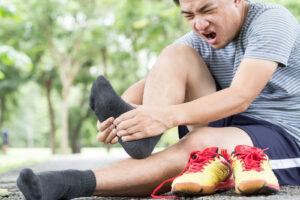What is it?
Tinea pedis also referred to as athlete’s foot is a common fungal skin infection that occurs on the feet. It is caused by three main types of dermatophyte fungi which thrive in warm and humid environments. Tinea can occur anywhere on the foot by most frequently presents in between the toes (interdigital tinea).

How did I get it?
Tinea pedis is usually spread via direct exposure to the dermatophyte. This type of infection is usually picked up in communal areas where people may walk barefoot including swimming pools, sauna’s, gyms, bathrooms and change rooms. As tinea is highly contagious direct contact with another infected person can transmit the fungi and through sharing of equipment such as towels and socks.
Signs and symptoms:
- Itchiness which is spreading or getting worse.
- Hot feet or feeling as if the feet are burning in certain locations.
- Maceration or wetness between the toes especially the 4th and 5th toe.
- Dry and scaley lesions or patches of skin which is also peeling.
- Erythema (redness) may be present especially underneath the sole of the foot.
- Pain may be present if skin splits open between the toes.
- Blisters or pustules may occur in the presentation of vestibular tinea pedis.
Risk factors for increased likelihood of developing tinea pedis:
- Having excessively sweaty feet which is referred to as hyperhidrosis.
- Non breathable sock material which trap moisture and don’t allow feet to breath.
- Certain occupations such as tradespeople or chefs which require occlusive work shoes to be worn for long hours.
- Using public pools, sauna’s, bathrooms and gyms.
- Sharing personal equipment such as towels or socks.
- Poor foot hygiene where feet are not washed and dried.
- Sporting clubs which share change rooms.
- People with compromised immune systems and underlying systemic health conditions.
- People taking medication which suppress the immune system.
- History of fungal skin infections.
How to treat Tinea pedis:
Most commonly anti-fungal creams and sprays are used to treat symptoms. It is important that these products are used for an extra 2 weeks after symptoms resolve. This is because fungal cells can lay dormant on the skin if not treated for long enough and cause reoccurrence of the infection. In some cases of persistent tinea oral tablets prescribed by a GP may be needed to systemically fight the fungal infection.
Other tips to help clear the infection include:
- Thorough washing of feet and drying well between the toes.
- Changing socks to a breathable material such as cotton.
- Frequent changing of socks if you do suffer from sweaty feet.
- Washing socks or innersoles of shoes with anti-fungal rinse/powder.
- Avoid walking barefoot in public facilities, always wear thongs or sandals.
- Wearing non-occlusive shoes.
- Spending time out of shoes when at home.
- Cleaning of shower base with products such as bleach which will destroy fungal cells.
- Using anti-perspirant sprays for feet to address excessive sweating.
Why it is important to treat tinea pedis:
If left untreated tinea pedis can lead to further complications. Breaks in skin offer a portal of entry for bacteria which can lead to serious conditions such as cellulitis which is a condition that requires immediate treatment. Furthermore, in severe cases ulceration may occur in between the toes if there is a break down in skin in people with diabetes. Additionally, tinea may spread to other areas of the feet and may contaminate the nails leading to onychomycosis which is traditionally difficult to treat.
If you suspect you may have tinea it is important to have this assessed by a podiatrist who can advise you on which products to use. Tinea can also present very similarly to other dermatological conditions which require different management to resolve symptoms.
